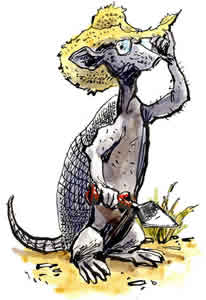
Hi, kids, I'm Dr. Dirt. I've been digging for lots more years than we nine-banded armadillos are supposed to live. But I'm not just any armadillo—I'm an archeologist, and I've studied the Texas past from El Paso to Port Arthur, Texarkana to Del Rio, and Brownsville to Pampa. Along the dusty trail, I've learned a thing or two about the over 500 generations of people who have called Texas home. That's my profession—archeology. What that means is, I study the lives of people of the past—sometimes from thousands of years ago—by looking at the things they left behind.
The answer, as I like to say, is in the dirt. Below you'll find answers to some of your questions on particular topics, grouped into three categories. In I Want to Be an Archeologist! I talk about how somebody becomes an archeologist. In Give a Hoot, Don't Loot I answer questions about why it is important to study archeology, not put it in your pocket. Last but never least, I Dig Texas contains answers to your questions about Texas archeology!
I Want to Be an Archeologist!
Q: Dr. Dirt, I want to be an archeologist when I grow up. Should I start digging in my backyard to practice?
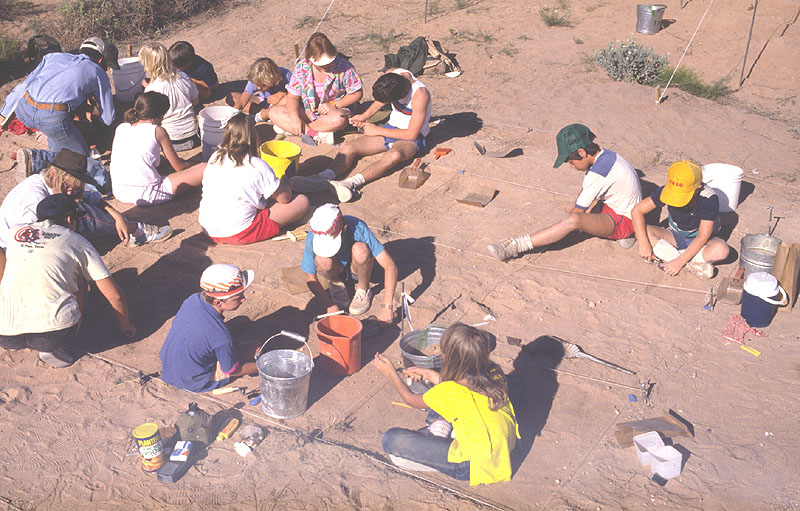
A: Well, it's not quite that simple. People train for many years before they actually become archeologists. You can begin by visiting museums and historical places, and by studying subjects like history, science and foreign languages. Travel whenever you can and make a point of going to historic sites (no, that doesn't mean the oldest ride at Disneyland)! If you're looking for an easy way into archeology—read! There are loads of books on history; you just have to find out what most interests you. You can also join a real archeological excavation through kid-friendly field school, such as the one held every June by the Texas Archeological Society!
Q: So I don't need to start digging anything up? I'm just sure there are some T-Rex bones under my dog's house.
A: If you're lucky enough to be able to participate in a real dig, go for it! There's no better way to see if you like archeology than to get covered in dirt and dust! Just remember, there are plenty of ways to dig up information on archeology long before you need to dig in the dirt. And by the way, paleontologists, not archeologists, study dinosaur bones. You better leave that dig to your dog.
Q: When do you get to officially be an archeologist?
A: Well, some archeologists are professionals. They earn their living doing archeology. Other archeologists are avocationals, and they do it in their spare time, so this is a two-part answer.
Most professional archeologists get a college degree in anthropology and start working as paid crew members on archeological digs to gain experience. Most of those who stick with it go on to graduate school, where they continue to study archeology. While you're in college, you take special classes that have to do with what you think is cool and interesting. For instance, you may need to learn about geology and geography and other earth sciences that have much in common with archeology. Archeologists also attend field school. No, they don't study fields, they learn how to dig up artifacts and study them! As you can guess, all this education can take a long time—years in fact. It's a good thing archeologists love history, because they have to learn plenty of it!
Most avocational archeologists belong to one or more archeological societies and associations such as the Texas Archeological Society (TAS). Many avocational archeologists also study archeology in college or go back to school later in life to learn more. Their most important training comes through archeological fields schools such as the one run by the TAS every June in various locations in Texas. And, the TAS field school has a special Kids field school! Avocational archeologists also learn lots just by reading and hanging out with other archeologists, especially on digs. Serious avocational archeologists often become experts in their local area or on a particular topic that interests them. Texas has a long history of avocational and professional archeologists working together to learn about the past.
Q: Wow! Can I get a good job after all that?
A: Oh, there are lots of jobs out there for professional archeologists: museums, government jobs, university work. But most archeologists spend only part of their time doing field work (remember—that's digging). The rest of the time, they're studying the artifacts they found and writing reports on them. These reports, just like a research report you write in class, share important information that helps others learn history. When you go to a museum, there are usually a few paragraphs written about each artifact on display. This information tells you what the artifact is and what it was used for. What if you went to a museum and saw a bunch of artifacts, but none of them had a story? That's exactly what would happen if we didn't have archeology reports! So as you can see, there's much more to an archeologist's job than digging.
Q: What's the hardest thing about being an archeologist?
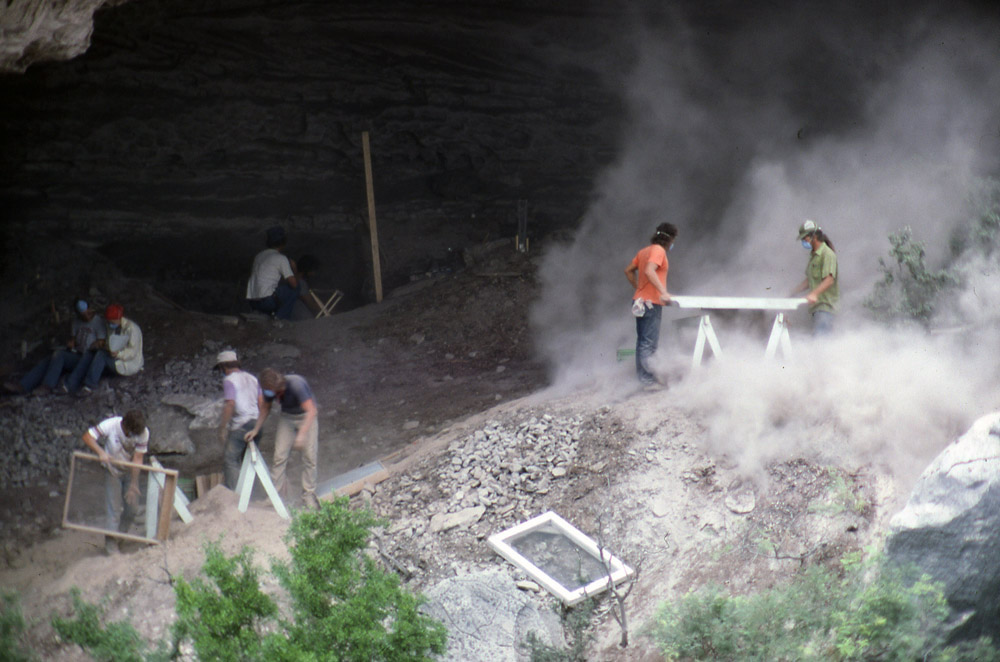
A: In most jobs, you don't get covered with dirt, your muscles don't get sore, you don't get dust in your eyes or an aching back. In archeology, you get all that and sometimes sunburns too! But that is what it takes to make exciting discoveries. Most archeologists, like me, actually love to dig. When I'm stuck in the laboratory for too long, I find myself in the backyard doing gardening or any other excuse to scratch up some dirt and have a little fun. The hardest part about being an archeologist for me is being patient. Out in the field, there are days when we don't find anything interesting at all. That can get pretty dull. But I live for the other days when someone makes a terrific discovery.
You might be surprised to learn that many of our most exciting discoveries come not in the field, but weeks or months later back in the lab when we finally put two and two together and realize something new about the past. Yes, archeologists must be very patient and, as you probably know, being patient is not easy!
Give a Hoot, Don't Loot (top)
Q: Hi Dr. Dirt. Dig this: If I'm out riding my bike or walking somewhere, and I find a really cool artifact, can I take it home?
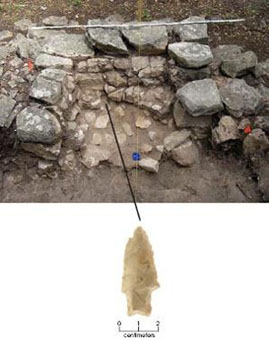
A: You may find an arrowhead, a piece of pottery, or some other artifact that you think is really interesting, but taking it away from its home means that you're taking a piece of history. Once that home site is changed, it can't be put back together again. An artifact's position (where it's located) in a site gives important clues about its story. For instance, finding a sandal near some charred stones in a cave might tell you that the owner was preparing or eating dinner when he took his shoes off. If the shoe or stones were moved or stolen, the archeologist documenting the site may miss some important information about that person's life, like whether they had really huge feet!
Q: What if I want to give something I find to a museum?
A: It's better to let professional archeologists do that. A dig may involve both archeologists and trained volunteers working to carefully excavate a site. The whole area is studied, and detailed reports are made about the land and each artifact found. These reports help explain how the artifact was preserved over time, why it was left in that place, and what life was like at that time in that geographic area. Once an artifact is removed, moved or damaged, it can never be studied in the same way again.
Imagine that someone goes into your bedroom and, without asking, takes a few of your toys. Then they move your bed to a different wall, tear some pages from your books, and leave some of their belongings on the floor (if you have a little brother or sister, you probably know exactly how this feels). Without being able to ask you, it would be hard to know where things are supposed to go, what is missing, and which items don't belong to you. Unfortunately, when you study people that lived long ago, they are no longer around to help you understand their homes, their belongings, and their lives. Archeologists are trained to help tell the stories of the past. These stories are much harder to tell each time a clue is removed. Besides, everyone knows it's just as rude to steal from dead people as from live ones.
Q: Why should I even care about the past?
A: Because the past helps us know where we came from and what the future will be like. We know some amazing facts about human history from archeological discoveries. For instance, we're sorry to break the news to you, but Michael Jordan did not invent basketball. In fact, the ancient Mayans were playing a somewhat similar ball game complete with rubber ball and stone hoop over a thousand years ago. We know this from discovering their ball courts! Every time you flush the toilet, you should say thank you to the people of the ancient Indus civilization along the Indus River in what is today Pakistan. They created one of the first, almost-modern forms of indoor plumbing over 4,000 years ago! Today farmers in the tropical jungles of Mexico are learning to use ancient farming techniques that are much more productive and better for the environment than so-called "modern" farming practices. But the biggest reason you should care about the past is because knowing and caring about the human past is one of the unique things that sets us apart from the other living creatures on Earth. Only humans study can preserve part of their past, and this knowledge helps us make better choices about our future. So you see, it's very important to protect the past—not only can we learn to appreciate those that came before us, but we can get a lot of good ideas for tomorrow!
Q: This all seems like pretty major stuff. Are there laws for stealing artifacts or damaging sites?
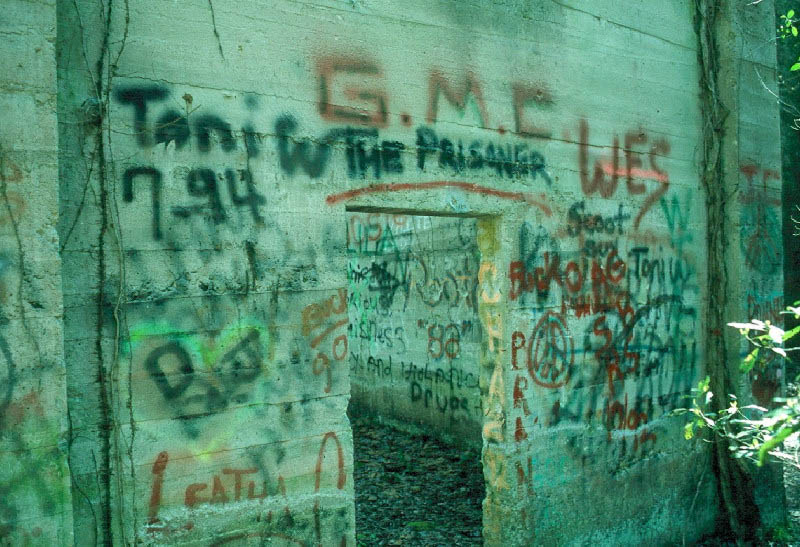
A: Yes, there are stiff laws against looting (stealing) and vandalism (damaging) artifacts on public property—state and city land, parks, forests, and so on. People who break these laws face big fines—even jail time—when they are caught harming a site. These laws exist to protect important "cultural resources" so that they can be properly studied or just left alone and saved for future generations. Here in Texas, most artifacts and sites on private land are not protected by law. Many landowners value knowledge about the past and protect the cultural resources on their property. Others do not and may intentionally destroy or dig up artifacts and sites just to get the "good stuff." This isn't against the law, but it's not a good idea. Just think, if everyone did that, we would lose many of our best clues to the past. Take the Alamo, for example. About 1900, that famous landmark was about to be destroyed to make way for more buildings in downtown San Antonio. If it wasn't for Clara Driscoll and the Daughters of the Republic of Texas, who stepped in and bought up the Alamo and surrounding properties, you wouldn't be able to visit it today!
I Dig Texas (top)
Q: What's the most famous archeological site in Texas?
A: Remember the Alamo!! That famous battle cry comes from the most well known site in Texas—but it's not known for its archeology. Everybody knows about the Alamo because of its role in Texas history. The Alamo began as a Spanish Mission, a church compound where Spanish priests and their Indian converts lived and worked. To convert means to change your religious beliefs. So the Indians that lived in the mission with the priests were being taught new and different beliefs. You probably don't know the Alamo as a church though. It's best known for the bloody battle that occurred there in 1836. Lots of artifacts from the Alamo's early history (before the battle) are still buried there. We archeologists work there every chance we get—usually before some construction project is set to start. The construction workers are going to tear up the land anyway, (to put in new sewer lines, create a new shopping area or some other project), so we get to go dig first!
One hot summer many years ago, I visited an air-conditioned dig at the Alamo! The old Radio Shack store across the street from the Alamo was supposed to be replaced by a shopping center. So after the store closed (and before they turned off the air-conditioning!), archeologists ripped up the wooden floor and started digging at the Alamo!
Q: But I thought you said the Alamo was across the street?
A: Most people think of the Alamo as the famous church with the interesting stone front. But the church was only one part of a much larger area, called a compound. The Radio Shack store was built on what was left of the Alamo's outer wall. Do you think modern shoppers buying the latest electronic gadget knew they were on top of an archeology site? Today, that wall is across a busy street from the building we think of as the Alamo. Indians used to live in that part of the Alamo back when it was still used as a mission. The Indian tribes (mostly families) suffered terribly from disease and war. They had to move to a new, strange place and learn ways of life that made little sense to them.
The people running the mission, Spanish priests, brought lots of things—olive oil, fancy painted pottery and religious ornaments—from Mexico and Europe. But under the floor of the Radio Shack store, archeologists found lots of evidence that the Mission Indians kept some of their traditional skills—pottery and stone tool making, for example. At the same time, European goods like metal tools were taking the place of many native things. Archeologists have found all kinds of artifacts there—they even found cannon balls and broken weapons from the famous battle! No, they didn't find a set of headphones and a CD player—and if they did, they would know it was left behind from Radio Shack—not the Native Americans!
I've got to tell you, it was cool to be digging in the air-conditioning on a hot August day!
Q: What are some of the Indian tribes archeologists study in Texas?
A: Well, most of the Indian sites we study are "prehistoric," also called "precontact." Remember, prehistory means before written history. None of the Indians that lived at those sites left behind a diary saying, "Today, I got sandals and salted fish for my birthday." That means that we often don't know a whole lot about them. Now, we do know the names of the historic tribes that were around when the Spanish and French explorers, traders, and missionaries showed up (in the 1500s and 1600s). Just think about it, something like 500 earlier generations of people lived on the same land you do. That means your great, great, great, great, great—say it 500 times—grandmother, could have lived in the land we call Texas, and we wouldn't know what languages she spoke or what the name of her tribe was. One thing is for sure, she wouldn't have been writing any of it down (although she may have drawn some pictures about her life. Archeologists call this "rock art")! Also, some "prehistoric" history is known through oral history, which is passed from an elder generation to a younger generation, over and over again. Some oral histories have been written down or continue to be remembered and told, but many more have been lost to time.
Q: Where can I go to see Texas artifacts?
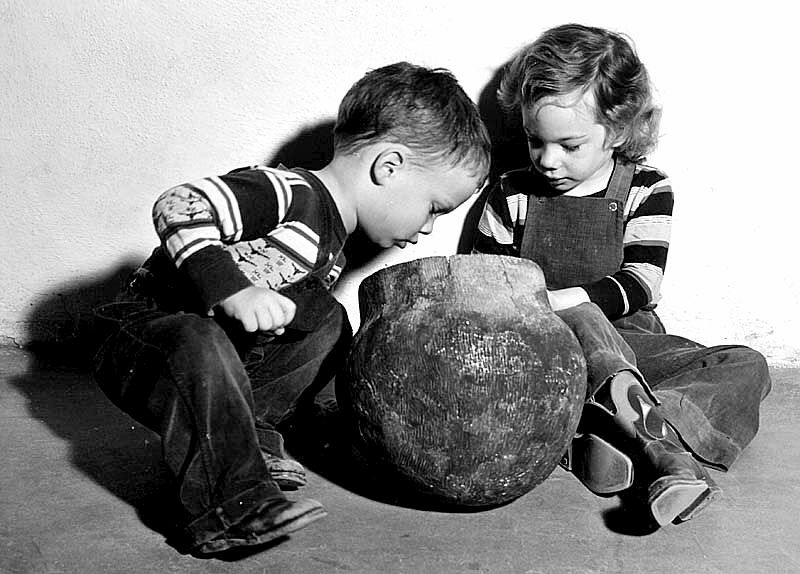
A: Wow—do I have a list for you! There are loads of museums in Texas. In fact, you could go to a museum every day for six months and still not see all of them! Of course, not every museum contains artifacts. Some contain modern art, or cultural items (like the Dr. Pepper museum) that are part of our modern society. Other artifact collections are in places that don't seem much like museums at all, for example, the French Legation in Austin. As for history museums, there's the The Bullock Texas State History Museum in Austin, the Texas Seaport Museum in Galveston, and the Institute of Texan Cultures in San Antonio. I could go on all day! Instead, how about checking these links for more ideas. You can find long lists of Texas museums, organized by region, on the List of Texas Museums Wikipedia. You can also search for museums in your county by going to the Texas Historic Sites Atlas and going to the "County" tab. Select your county and check the "museums" box to get your results list.
Q: Who were the first people living in Texas?
A: Here's a scientific answer for you—we don't know! If you're going to learn to be an archeologist, you're also going to have to learn to say, "I don't know!" After all, the whole science of archeology is trying to find answers to unanswered questions about the past. There's bound to be times when you just don't have a clue—half the fun is getting to look for them! So here's what we do know: the earliest Texas residents we're sure about were people we call "Clovis" after the special spear points they made. One of the largest and most impressive Clovis sites in North America is right here in Texas near Georgetown. It is called the "Gault" site and archeologists from the Texas Archeological Research Laboratory are researching the site now. You can read more about it in the Gault exhibit.
Q: Have any dinosaur bones ever been found in Texas?
A: Sure, lots of them, but that's not my job. I'm an archeologist and that means I study the things that people, not the T. Rex or the Tyrannosaurus, left behind. Dinosaurs lived in Texas long, long ago—millions of years before the first humans arrived. Forget Jurassic Park, no dinosaur ever saw a human being and no human being ever saw a (living) dinosaur. The scientists who study dinosaurs are called "paleontologists" and you can learn more about them by visiting the website of the Texas Memorial Museum.
Q: Did ancient people in Texas live in towns? If so, where are the towns now?

A: The Indians who lived in Texas for at least 13,000 years before the Spanish arrived lived in all sorts of places. Some of them were large villages where hundreds of people lived—a good example is the place now known as Caddo Mounds State Historic Site. We don't know its ancient name, but the ancestors of the modern Caddo Indians lived there about a thousand years ago. Other Indians often set up temporary camps along streams and rivers, near springs, and many other places. Now, why do you think they liked to live near streams and rivers? I'll give you a hint—there was no McDonald's around. On hot summer days, Native Americans couldn't roll into the drive-through saying, "Can you super-size that Coke?" One example of a prehistoric village is the Graham-Applegate rancheria near Kingsland, Texas. Rancheria is a Spanish word that means temporary village.
Q: What kind of houses did ancient Texans have?
A: Lots of different kinds. In dry west Texas, the Indians often used natural houses—caves and rockshelters—when they needed to get in out of the weather. But usually they lived in the open, under the stars. You might be thinking, "Hey, cool! Just like camping!" Of course, anyone camping these days knows they can go back to their cozy house if it starts to rain, or snow, or if the wind is blowing their tent down. But the weather could be a real problem for Indians living in temporary shelter. In the winter, most groups built some sort of house that kept them warmer, drier and safer. The Caddo Indians of east Texas built large houses out of wood and grass that were shaped like giant beehives. The Mogollon Indians of far west Texas (near what is now El Paso) built rectangular pueblos out of mud bricks called adobe. Take a look at the one we archeologists named Firecracker Pueblo. The people who lived in the Panhandle sometimes dug large holes in the ground and built a roof over this "pithouse"—the earth acted as insulation to keep the pithouses warm.
Q: What about tepees like we see in the movies?
A: To build a tepee, Native Americans needed long poles and lots of buffalo hides. They are pretty heavy and can only be moved by horse (or automobile). Before automobiles and before the Spanish brought horses back to North America, there were no tepees. When the Plains Indian groups like the Comanche got horses, their lives completely changed. Instead of staying pretty much in one area, they moved wherever they wanted (to hunt buffalo) and dragged their teepee poles behind them with their horses. Hey, can you imagine dragging your house behind you while you went to find food? That could really work up your appetite!
Q: How do you know where ancient people lived?

A: We look for clues like artifacts, animal bones, and old campfires. If you know what you are looking for and you know where to look, there are lots of clues left behind by prehistoric peoples all over Texas. Clues like broken stone tools, fire-cracked cooking rocks, burned deer bones, clam shells, pieces of pottery, and all sorts of other things. Often, we find these traces in the same places where people live today—near reliable sources of water: creeks, rivers, and springs. But the clues are often hard to spot unless you have a trained eye and look carefully. Sometimes we find clues on the surface of the ground or perhaps on the side of a creek bank. But other times we have to dig. Hey, that's what I do best—I'm an armadillo after all—an armadillo archeologist! Texas is my home state, and it's full of the two things I love the most—dirt, and history—yahoo!!
